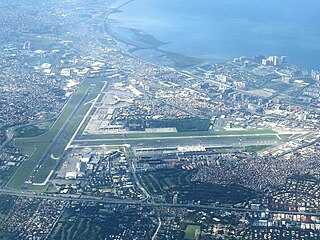Related Research Articles

Transportation in the Philippines covers the transportation methods within this archipelagic nation of over 7,500 islands. From a previously underdeveloped state of transportation, the government of the Philippines has been improving transportation through various direct infrastructure projects, and these include an increase in air, sea, road, and rail transportation and transport hubs.

Western Visayas is an administrative region in the Philippines, numerically designated as Region VI. It consists of six provinces and two highly urbanized cities. The regional center is Iloilo City. The region is dominated by the native speakers of four Visayan languages: Hiligaynon, Kinaray-a, Aklanon and Capiznon. The land area of the region is 20,794.18 km2 (8,028.68 sq mi), and with a population of 7,954,723 inhabitants, it is the second most populous region in the Visayas after Central Visayas.

Ninoy Aquino International Airport, originally known as Manila International Airport (MIA), is the main international airport serving the Manila metropolitan area in the Philippines. Located between the cities of Pasay and Parañaque, about 7 kilometers (4.3 mi) south of Manila proper and southwest of Makati, it is the main gateway for travelers to the Philippines and serves as a hub for AirSWIFT, PAL Express, and Philippine Airlines. It is also the main operating base for Cebgo, Cebu Pacific, and Philippines AirAsia.

The Polillo Islands is a group of about 27 islands in the Philippine Sea lying about 25 km (16 mi) to the east of the Philippine island of Luzon. It is separated from Luzon Island by the Polillo Strait and forms the northern side of Lamon Bay. The islands are part of the province of Quezon in the Calabarzon region of the Philippines. The combined land area of all the islands is about 875 square kilometers making Polillo islands even larger than the island city-state of Singapore.

Clark International Airport, known as Diosdado Macapagal International Airport from 2003 to 2014, is an international airport covering portions of the cities of Angeles and Mabalacat within the Clark Freeport Zone in the province of Pampanga, Philippines. It is located 80 kilometers (50 mi) northwest of Manila. It is accessible by way of the Subic–Clark–Tarlac Expressway (SCTEX).

Jomalig, officially the Municipality of Jomalig, is a 5th class municipality in the province of Quezon, Philippines. According to the 2020 census, it has a population of 7,667 people.

Patnanungan, officially the Municipality of Patnanungan, is a 5th class municipality in the province of Quezon, Philippines. According to the 2020 census, it has a population of 15,052 people.

Tourism is an important sector for the Philippine economy. The travel and tourism industry contributed 6.2% to the country's GDP in 2022; this was lower than the 12.7% recorded in 2019 prior to the COVID-19 lockdowns. Coastal tourism, encompassing beach and diving activities, constitutes 25% of the Philippines' tourism revenue, serving as its primary income source in the sector. Popular destinations among tourists include Boracay, Palawan, Cebu and Siargao. While the Philippines has encountered political and social challenges that have affected its tourism industry, the country has also taken steps to address these issues. Over the past years, there have been efforts to improve political stability, enhance security measures, and promote social inclusivity, all of which contribute to creating a more favorable environment for tourism, such as the Boracay rehabilitation.

San Jose Airport, formerly known as McGuire Field, is an airport serving the general area of San Jose, Occidental Mindoro in the Philippines. It is one of three airports in Occidental Mindoro, the others being Mamburao Airport and Lubang Airport. The airport is classified as a Principal class 1 domestic airport by the Civil Aviation Authority of the Philippines, an agency of the Department of Transportation that is responsible for the operations of not only this airport but also of all other airports in the Philippines, except the major international airports.

The Civil Aviation Authority of the Philippines is the civil aviation authority of the Philippines and is responsible for implementing policies on civil aviation to assure safe, economic and efficient air travel. The agency also investigates aviation accidents via its Aircraft Accident Investigation and Inquiry Board. Formerly the Air Transportation Office, it is an independent regulatory body attached to the Department of Transportation for the purpose of policy coordination.

The Philippine narrowmouth toad or the truncate-toed chorus frog is a species of frog in the family Microhylidae. It is endemic to the Philippines. Its natural habitats are subtropical or tropical dry forests, subtropical or tropical moist lowland forests, subtropical or tropical moist shrubland, subtropical or tropical seasonally wet or flooded lowland grassland, rivers, intermittent rivers, freshwater lakes, intermittent freshwater lakes, freshwater marshes, intermittent freshwater marshes, arable land, pastureland, plantations, rural gardens, heavily degraded former forest, water storage areas, ponds, irrigated land, and seasonally flooded agricultural land. It is threatened by habitat loss.

Bohol–Panglao International Airport, also known as New Bohol International Airport, is an international airport on Panglao Island in the province of Bohol, Philippines. The airport opened on November 28, 2018 after decades of planning and three years of construction, replacing Tagbilaran Airport to support Bohol's increased passenger traffic due to tourism. The airport serves as the gateway to Tagbilaran and the rest of mainland Bohol for domestic air travellers. It also is less than an hour's flight from Mactan–Cebu International Airport, which is a gateway to central Philippines for international tourists.
The Manila International Airport Authority is a government-owned and controlled corporation and agency under the Department of Transportation of the Philippines responsible for the management of Ninoy Aquino International Airport (NAIA) formerly Manila International Airport. MIAA was created by virtue of Executive Order No. 778 signed in 1982 by President Ferdinand Marcos.

Quezon, officially the Province of Quezon, is a province in the Philippines located in the Calabarzon region on Luzon. Kaliraya/Kalilayan was the first known name of the province upon its creation in 1591. Around the middle of the 18th century, it was changed to Tayabas. In recognition of the second president of the Philippines, Manuel L. Quezon, the name of Tayabas Province is changed to Quezon. Lucena, the provincial capital, the seat of the provincial government, and the most populous city of the province, is governed independently from the province as a highly urbanized city. To distinguish the province from Quezon City, it is sometimes called Quezon Province, a variation of the province's official name.
Local elections were held in the province of Quezon on May 13, 2013, as part of the 2013 general election. Voters will select candidates for all local positions: a town mayor, vice mayor and town councilors, as well as members of the Sangguniang Panlalawigan, the vice-governor, governor and representatives for the four districts of Quezon.

Central Visayas is an administrative region in the Philippines, numerically designated as Region VII. It consists of four provinces: and three highly urbanized cities: Cebu City, Lapu-Lapu, and Mandaue).

Mactan–Cebu International Airport is an international airport serving Cebu and serves as the main gateway to the Central Visayas region in the Philippines. Located on a 797-hectare (1,970-acre) site in Lapu-Lapu City on Mactan, it is the second busiest airport in the Philippines. Opened on April 27, 1966, the airport serves as a hub for Philippine Airlines, and as an operating base for Cebu Pacific and Philippines AirAsia.